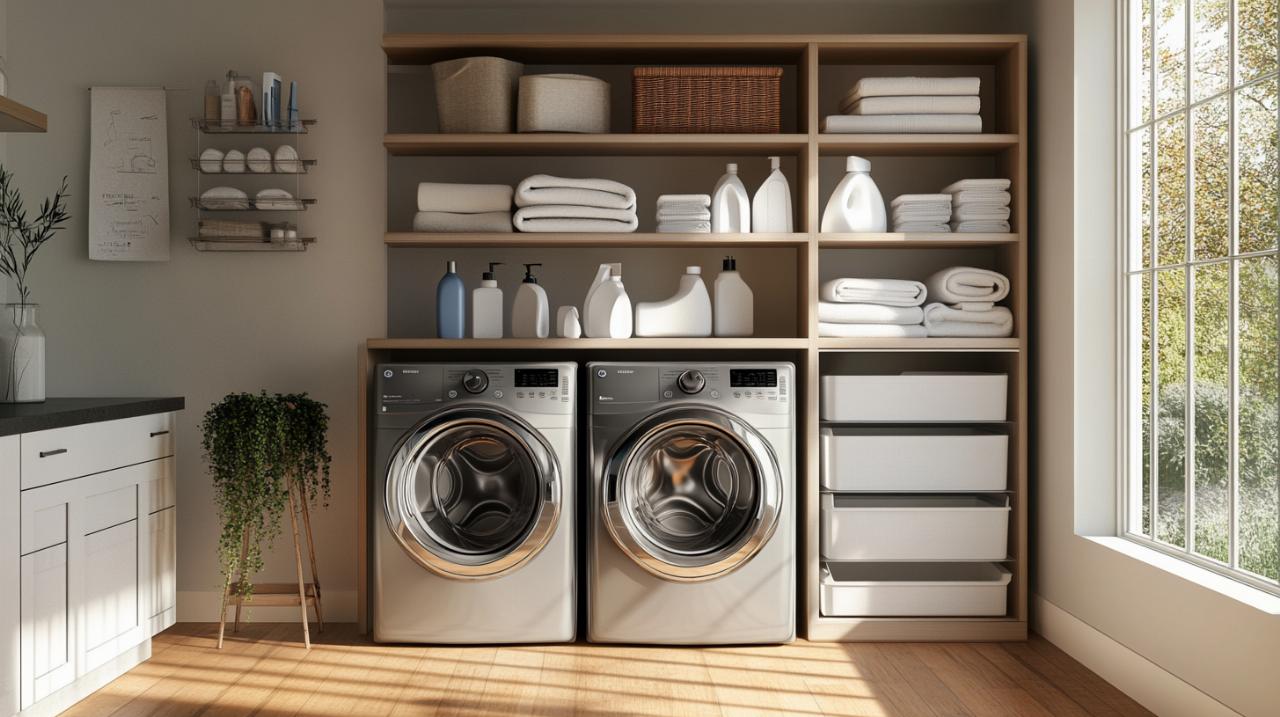When floor space in your utility room or kitchen is at a premium, stacking your washing machine and tumble dryer presents an ingenious solution. This configuration not only conserves valuable square footage but also creates a more streamlined appearance. However, achieving this setup requires careful planning and attention to detail. By following practical guidance and using the right equipment, you can ensure your appliances remain secure, functional, and efficient for years to come.
Choosing and preparing compatible appliances
Selecting the Right Models for Stacking
Not every washing machine and tumble dryer is designed to be stacked. Before you begin, it is essential to verify that both appliances are suitable for this arrangement. Manufacturers typically specify whether their models can be safely stacked, and this information is often found in the instruction manual or on their official websites. Front-loading washing machines are generally the preferred choice for stacking, as their design provides a stable base. Top-loading machines, on the other hand, are not compatible with this configuration. It is also worth considering the dimensions of each appliance. Most stacking kits accommodate machines with depths ranging from forty-seven to sixty-two centimetres, so measuring your appliances beforehand will save you time and potential frustration. If your washing machine and tumble dryer are from different manufacturers, ensure that a universal stacking kit is available and compatible with both models. This early attention to compatibility will help you avoid damaging your stacked washer-dryer setup and prevent costly mistakes down the line.
Investing in a Proper Stacking Kit
A stacking kit is not a luxury but a necessity when it comes to safely positioning your tumble dryer atop your washing machine. These kits are specifically engineered to distribute weight evenly and absorb the vibrations generated during the spin and drying cycles. Attempting to stack appliances without a proper kit, using makeshift materials or odds and sods, is a recipe for disaster. The kit serves as a stable platform that prevents the dryer from sliding, tipping, or falling, all of which could result in significant damage to your appliances and potential injury. Universal kits are widely available and tend to be more affordable, making them a practical choice if your machines are from different brands. However, specific kits designed for particular manufacturers offer a more precise fit and often include additional features such as shelves for storing cleaning products. When selecting a stacking kit, check the weight limit it can support. Most kits are rated to hold around twelve kilograms, which is sufficient for standard tumble dryers. Look for kits constructed from robust metal or high-quality plastic, and ensure they include non-slip elements to keep the dryer securely in place. Straps or metal brackets are also important, as they provide extra stability and prevent any unwanted movement during operation.
Safe installation and levelling practices
Handling appliances during installation
Moving and positioning washing machines and tumble dryers requires care and caution. These appliances are hefty, with a typical clothes dryer weighing anywhere from forty-five to sixty kilograms. Dropping or mishandling them during installation can cause internal damage, scratches, or even personal injury. It is advisable to enlist the help of at least one other person when lifting and positioning the dryer onto the stacking kit. Before you begin, clear the area of any obstacles and ensure you have a clear path from the storage location to the installation site. Take your time and communicate with your helper to coordinate each movement. Once the washing machine is in place, attach the stacking kit according to the manufacturer's instructions. This usually involves securing the kit to the top of the washing machine using screws or brackets. When lifting the dryer, keep your back straight and bend at the knees to avoid strain. Position the dryer carefully onto the kit, ensuring it is centred and stable. Use any straps or bands provided with the kit to secure the dryer firmly in place. This careful approach not only protects your appliances but also ensures a safe and successful installation.
Ensuring your washing machine is properly levelled
A level washing machine is the foundation of a stable stacked setup. If the base appliance is unbalanced, the entire configuration becomes prone to excessive vibration, noise, and even movement. Before you stack the tumble dryer, use a spirit level to check that the washing machine is perfectly horizontal. Most washing machines have adjustable legs that can be screwed in or out to achieve the correct level. Adjust these legs until the bubble in the spirit level sits centrally, indicating that the machine is even. It is worth taking the time to double-check this from multiple angles, as even a slight tilt can lead to problems. Once the washing machine is level, ensure that all four feet are in firm contact with the floor. This will minimise movement during the spin cycle and reduce the stress placed on the stacking kit. Remember that the floor itself should be solid and level. If you are working on an uneven surface, you may need to make additional adjustments or consider using anti-vibration pads to compensate. A properly levelled washing machine not only supports the dryer more effectively but also contributes to the overall efficiency and longevity of both appliances.
Maintaining your stacked setup for longevity
Regular Inspections of Hoses and Vents
Once your stacked washer-dryer setup is in place, ongoing maintenance is key to preventing issues and extending the lifespan of your appliances. One of the most important tasks is to regularly inspect the hoses and vents. The water supply hoses on your washing machine can become worn or kinked over time, which may lead to leaks or reduced water pressure. Similarly, the dryer vent can accumulate lint and debris, restricting airflow and increasing the risk of overheating. Every few months, take a few moments to examine the hoses for signs of wear, such as cracks or bulges, and replace them if necessary. Check that the connections are tight and free from leaks. For the tumble dryer, ensure that the vent hose is not blocked and that air can flow freely to the outside. Cleaning the lint filter after each use is also essential, as a clogged filter can reduce drying efficiency and place additional strain on the appliance. By staying on top of these simple maintenance tasks, you can help ensure that your stacked setup operates safely and efficiently, reducing the likelihood of unexpected breakdowns or damage.

Monitoring for Vibrations and Unusual Noises
Even the most carefully installed stacked washer-dryer setup can develop issues over time. It is important to remain vigilant for any signs of trouble, such as excessive vibrations, unusual noises, or visible movement. These symptoms often indicate that something is amiss, whether it is a loose component, an unbalanced load, or a problem with the stacking kit itself. If you notice any of these warning signs, stop using the appliances immediately and investigate the cause. Check that all screws and brackets on the stacking kit are still tight, as they can work loose over time due to the constant vibrations. Inspect the washing machine to ensure it is still level and that the feet are in firm contact with the floor. If the problem persists, it may be necessary to consult a qualified engineer or contact the manufacturer for advice. Addressing these issues promptly will help prevent further damage and ensure the safety of your household. Ignoring unusual noises or vibrations can lead to more serious problems, including damage to the appliances or the stacking kit, so it is always better to err on the side of caution.
Operational best practices
Avoiding overloading your appliances
One of the most common mistakes people make with stacked washer-dryer setups is overloading the appliances. Cramming too many clothes into the washing machine or dryer not only reduces their effectiveness but also places undue stress on the entire setup. An overloaded washing machine will shake more during the spin cycle, which can cause the stacked dryer to wobble or even shift position. This excessive movement can damage the stacking kit, loosen screws, and potentially lead to the dryer falling off. To avoid this, always adhere to the manufacturer's recommended load capacity for both appliances. Distribute the clothes evenly within the drum to ensure balanced operation. For the tumble dryer, filling it beyond its capacity will prevent proper air circulation, resulting in longer drying times and increased energy consumption. It also adds unnecessary weight to the stacking kit, which can compromise its structural integrity. By respecting the load limits and spreading the laundry evenly, you will not only protect your appliances but also achieve better washing and drying results. This simple practice is one of the most effective ways to avoid damaging your stacked washer-dryer setup and to keep everything running smoothly.
Allowing adequate space for air circulation
Proper ventilation is crucial for the safe and efficient operation of both your washing machine and tumble dryer. When installing your stacked setup, ensure that there is sufficient space around the appliances to allow air to circulate freely. This is particularly important for the tumble dryer, which generates a significant amount of heat during operation. If the appliances are crammed into a tight space with little room for airflow, the dryer may overheat, leading to reduced performance and potential damage. Additionally, adequate space around the machines makes it easier to access them for routine maintenance, such as cleaning filters, inspecting hoses, and checking the stacking kit. As a general rule, leave a few centimetres of clearance on all sides of the appliances and ensure that the vent hose has a clear path to the outside. If your utility room is small, consider installing an extractor fan to improve ventilation. Proper airflow not only protects your appliances but also helps to prevent issues such as mould and dampness, which can develop in poorly ventilated spaces. By prioritising ventilation in your installation, you will contribute to the overall safety and longevity of your stacked washer-dryer setup.
Professional installation and safety considerations
When to Call a Qualified Engineer
While many homeowners feel confident tackling the installation of a stacked washer-dryer setup themselves, there are situations where professional assistance is advisable. If you are unsure about any aspect of the installation process, or if the appliances are particularly heavy or awkward to manoeuvre, it is better to call in a qualified engineer. A professional will have the expertise and equipment to carry out the job safely and correctly, ensuring that the stacking kit is properly fitted and that both appliances are securely positioned. This is particularly important if you have opted for a specific stacking kit designed for your brand of appliances, as these may require precise installation to function correctly. Additionally, if your utility room or kitchen has limited space, uneven flooring, or other complications, a professional can assess the situation and recommend the best solution. Investing in professional installation can save you time, effort, and potential headaches, and it provides peace of mind that the job has been done to a high standard. It is also worth noting that some manufacturers may require professional installation to validate the warranty on your appliances, so check the terms and conditions before proceeding on your own.
Using anti-vibration pads to reduce movement
Anti-vibration pads are a simple yet effective addition to any stacked washer-dryer setup. These pads are designed to absorb the vibrations generated by the appliances during operation, reducing noise and movement. They are typically placed under the feet of the washing machine, where they act as a buffer between the appliance and the floor. By dampening vibrations, these pads help to keep the entire stacked setup more stable and reduce the wear and tear on both the appliances and the stacking kit. Anti-vibration pads are particularly useful if you have an older washing machine or if your floor is not perfectly level. They are inexpensive and easy to install, making them a worthwhile investment for anyone looking to improve the stability of their stacked setup. In addition to protecting your appliances, anti-vibration pads can also reduce noise levels, which is especially beneficial if your utility room is located near living areas or bedrooms. By incorporating these pads into your installation, you can further minimise the risk of damage and ensure that your stacked washer-dryer setup operates quietly and efficiently for years to come.







